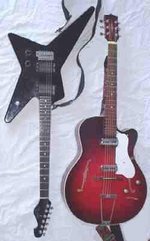
Left: Rosa Hurricane, a heavy metal-style solid body guitar.
Right: Maton Freshman, a hollow body electric guitar.
An electric guitar is a type of guitar that uses electronic pickups to convert the vibration of its steel-cord strings into electrical
current. The signal may be electrically altered to achieve various tonal effects prior to being fed into an amplifier, which produces the final
sound which can be either an electrical sound or an acoustic sound. Distortion, equalization, or other pedals can change the sound that is
emitted from the amplifier.
The electric guitar is used extensively in many popular styles of music, including almost all genres of rock and roll, country music, pop music,
jazz, blues, and even contemporary classical music. Its distinctive sound and intimate association with many legendary internationally-famous
musicians has made it the signature instrument of late twentieth-century music. Specialised steel guitars, although they are also electric
instruments descended from the guitar, are normally not considered electric guitars but rather as a separate instrument. This distinction has
important consequences on claims of priority in the history of the electric guitar.
Types

Both the North America-built Godin LG (left) and the Squier Stratocaster (right) are solid-body electric guitars, but they differ
significantly in design, including scale length, neck woods, body woods, and pickup type.
There are three main types of electric guitar:
- Hollow body electric guitar
- Electric acoustic guitar
- Solid body guitar
Electric acoustic guitars
Some steel-string acoustic guitars are fitted with pickups purely as an alternative to using a separate microphone. These are called electric
acoustic guitars, and are regarded as acoustic guitars rather than electric guitars. These should not be confused with hollow body electric
guitars, which are more of electric guitars fitted with hollow sound chambers.
Seven-string guitars
Seven-string guitars exist, most of which add a low B string below the E. They were popularized by Steve Vai and others in the 1980s, and have
been recently revived by some nu metal bands (such as Korn). Jazz guitarists using a seven-string include veteran jazz guitarist Bucky Pizzarelli
and his son John Pizzarelli. The seven-string guitar has also played an essential role in progressive rock, and is commonly used in bands such as
Dream Theater and by experimental guitarists such as Ben Levin. Another common seven-string arrangement is a second G string situated beside the
standard G string and tuned an octave higher, in the same manner as a twelve-stringed guitar (see below).
Eight-string guitars
Eight-string electric guitars are rare but exist, such as the one played by Charlie Hunter (manufactured by Novax Guitars), but they are extremely
unusual. The largest manufacturer of 8- to 14-strings is Warr Guitars. Their models are used by Trey Gunn (of King Crimson) who has his own
signature line from the company.
Twelve-string guitars
Twelve string electric guitars feature six pairs of strings, usually with each pair tuned to the same note. The extra E, A, D, and G strings add
a note one octave above, and the extra B and E strings are in unison. The pairs of strings are played together as one, so the technique and tuning
are the same as a conventional guitar, although creating a much fuller tone. They are used almost solely to play chords and are relatively common
in folk rock music.
Double neck guitars
Jimmy Page, an innovator of hard rock, used and made famous custom Gibson electric guitars with two necks - essentially two instruments in one;
in his case, a 6-string and 12-string guitar, to replicate his use of two different guitars when playing live "Stairway to Heaven" so that he didn't
have to pause to switch from one section to another. These are commonly known as double-neck (or, less commonly, "twin-neck") guitars. The purpose
is to obtain different ranges of sound from each instrument; typical combinations are six-string and four-string (guitar and bass guitar) or, more
commonly, a six-string and twelve-string. Such a combination may come handy when playing ballads live, where the 12-string gives a mellower sound
as accompaniment, while the 6-string may be used for a guitar solo. English progressive rock bands such as Genesis took this trend to its zenith
using custom made instruments produced by the Shergold company. Rick Nielsen, guitarist for Cheap Trick, uses a variety of custom guitars, many of
which have five necks, with the strap attached to the body by a swivel so that the guitar can be rotated to put any neck into playing position - more
for comic effect than for actual usefulness. Guitar virtuoso Steve Vai occasionally uses a triple-neck guitar; one neck is twelve string, one is six
string and the third is a fretless six string. Claudio Sanchez of Coheed & Cambria, has also recently been using a double neck guitar. He uses it
on the track Welcome Home.
History
Adolph Rickenbacker invented the electric guitar. The popularity of the electric guitar began with the big band era because amplified instruments
became necessary to compete with the loud volumes of the large brass sections common to jazz orchestras of the thirties and forties. Initially,
electric guitars consisted primarily of hollow archtop acoustic guitar bodies to which electromagnetic transducers had been attached.
Early years
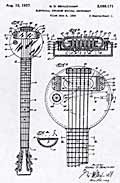
Sketch of Rickenbacker "frying pan" lap steel guitar from 1937 patent application.
Electric guitars were originally designed by an assortment of luthiers, electronics enthusiasts, and instrument manufacturers, in varying
combinations. Some of the earliest electric guitars, then essentially adapted hollow bodied acoustic instruments, used tungsten pickups and
were manufactured in the 1930s by Rickenbacker. In 1935, a Soviet scientist working separately from his western colleagues was known to have
produced an electric Russian guitar called the "Kuznetsov electromagnetic guitar". It was exhibited at a technology expo in Moscow, but its
development was halted since the Stalin regime was hostile to guitar music.
The first recording of an electric guitar was by jazz guitarist Eddie Durham in 1937. Durham introduced the instrument to a young Charlie Christian,
who made the instrument famous in his all-too-brief life and is generally known as the first electric guitarist and a major influence on jazz
guitarists for decades thereafter.
The version of the instrument that is best known today is the [solid body] electric guitar, a guitar made of solid wood, without resonating
airspaces within it.
At least one company, Audiovox, built and may have offered an electric solid-body as early as the mid-1930s. Rickenbacher, later spelled
Rickenbacker (both are pronounced Rickenbocker) offered a cast aluminum electric guitar, nicknamed "The Frying Pan" or "The Pancake
Guitar", beginning in 1933, which reportedly sounded quite modern and aggressive when tested by vintage guitar researcher John Teagle. Mike Neer
adds that an example of this sound can be heard on the early recordings of Andy Iona and Dick McIntire, both Hawaiian steel guitarists.
Another early solid body electric guitar was designed and built by musician and inventor Les Paul in the early 1940s, working after hours in the
Gibson Guitar factory. His "log" guitar (so called because it consisted of a simple 4x4 wood post with a neck attached to it and homemade pickups
and hardware, with two detachable Swedish hollow body halves attached to the sides for appearance only) was patented and is often considered to be
the first of its kind, although it shares nothing in design or hardware with the solid body "Les Paul" model sold by Gibson.
Fender
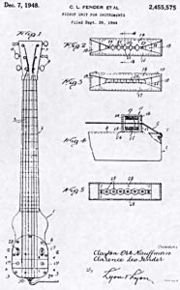
Sketch of Fender lap steel guitar from 1944 patent application.
In 1950 and 1951, electronics and instrument amplifier maker Clarence Leonidas Fender - better known as Leo Fender - through his eponymous company,
designed the first commercially successful solid-body electric guitar with a single magnetic pickup, which was initially named the "Esquire". The
two-pickup version of the Esquire was called the "Broadcaster". However, Gretsch had a drumset marketed with a similar name (Broadkaster), so Fender
changed the name to "Telecaster" in homage to the new phenomenon of television. Features of the Telecaster included: an ash body; a maple 25 1/2" scale,
21-fret neck attached to the body with four-bolts reinforced by a steel neckplate; two single-coil, 6-pole pickups (bridge and neck positions) with
tone and volume knobs, pickup selector switch; and an output jack mounted on the side of the body. A black bakelite pickguard concealed body routings
for pickups and wiring. The bolt-on neck was consistent with Leo Fender's belief that the instrument design should be modular to allow cost-effective
and consistent manufacture and assembly, as well as simple repair or replacement. Due to the earlier mentioned trademark issue, the earliest Telecasters
were delivered with headstock decals with the Fender logo but no model identification, and are commonly referred to by collectors as "Nocasters".
In 1954, Fender introduced the Fender Stratocaster, or "Strat". It was positioned as a deluxe model and offered various product improvements and
innovations over the Telecaster. These innovations included an ash or alder double-cutaway body design for badge assembly with an integrated vibrato
mechanism (called a synchronized tremolo by Fender, thus beginning a confusion of the terms that still continues), three single-coil pickups,
and body comfort contours. Leo Fender is also credited with developing the first commercially-successful electric bass> called the Fender Precision
Bass, introduced in 1951.
Gibson
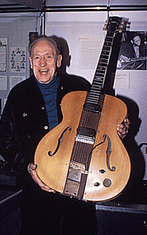
Les Paul with his "log" solid body electric guitar.
Gibson, like many guitar manufacturers, had long offered semi-acoustic guitars with pickups, and previously rejected Les Paul and his "log" electric
in the 1940s. In apparent response to the Telecaster, Gibson introduced the first Gibson Les Paul solid body guitar in 1952 (although Les Paul was
actually brought in only towards the end of the design process for expert fine tuning of the nearly complete design and for marketing endorsement.
Features of the Les Paul include a mahogany body with a carved maple top (much like a violin) and contrasting edge binding, two single-coil "soapbar"
pickups, a 24 3/4" scale mahogany neck with a more traditional glued-in "set" neck joint, binding on the edges of the fretboard, and a tilt-back headstock
with three tuners to a side. The earliest models had a combination bridge and trapeze-tailpiece design that was in fact designed by Les Paul himself,
but was largely disliked and discontinued after the first year. Gibson then developed the Tune-o-matic bridge and separate stop tailpiece, an adjustable
non-vibrato design that has endured. By 1957, Gibson had made the final major change to the Les Paul as we know it today - the humbucking pickup, or
humbucker. The humbucker, invented by Seth Lover, was a dual-coil pickup which featured two windings connected out of phase and reverse-wound, in order
to cancel the 60-cycle hum associated with single-coil pickups; as a byproduct, however, it also produces a distinctive, more "mellow" tone which
appeals to many guitarists. The more traditionally designed and styled Gibson solid-body instruments were a contrast to Leo Fender's modular designs,
with the most notable differentiator being the method of neck attachment and the scale of the neck (Gibson-24.75", Fender-25.5"). Each design has its
own merits. To this day, the basic design of many solid-body electric guitar available today are derived from the original designs - the Telecaster,
Stratocaster and the Les Paul.
Tuning
Most electric guitars are fitted with six strings and are usually tuned in standard - from lowest pitch to highest - E-A-D-G-B-E, in the same fashion
as an acoustic guitar, although many guitarists occasionally tune their instruments differently, including dropped D, various transposed and open
chord tunings, usually to simplify fretting of some chord inversions in a certain key. Some guitarists also tune to very low tunings, some almost 4
whole steps down from the standard tuning, causing the strings to sometimes over-vibrate.
Pickups
Electric guitars are not amplified by using a microphone, but with magnetic pickups that sense the movement of strings. Although some hybrid
electric-acoustics are equipped with additional acoustic pickups that sense vibration mechanically off the body, this is not common (you can't yell
into an electric guitar pickup). This is because the internal components are embedded or "potted" in epoxy or wax to prevent the pickup from having
a microphonic effect. Single coil magnetic pickups also tend to pick up ambient electromagnetic noises, the so-called "hum", with a strong 50 or 60
Hz component depending on the frequency used in the local power transmission system. All sorts of electric appliances produce this kind of
interference. Hum is annoying, especially when playing with distortion, so double-coil or "humbucker" pickups were invented to counter this.
Humbuckers have two coils of opposite magnetic polarity, so that electromagnetic noise hitting both coils simultaneously cancels itself out. The two
coils are wired in phase, so that the signal picked up by each coil is added together. This creates the richer, "fatter" tone associated with
humbucking pickups. The same effect can be achieved on guitars such as Fender's Stratocaster, in which two single-coil pickups can be active at the
same time to cancel the hum.
Operational principles
The working principles of electric guitars are primarily based on induced currents and circuits. Magnets are located under each ferromagnetic string,
magnetising the strings and causing them to behave as magnets themselves. When a string is played, it oscillates at a certain frequency, causing the
magnetic field it creates to oscillate with it. Solenoids (electromagnetic coils) are wrapped around each magnet, giving an induced alternating
current at the same frequency. When this travels to an amp, the result is a sound produced at exactly the same pitch as the string.
Tremolo arms
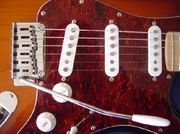
Detail of a Squier-made Fender Stratocaster. Note the tremolo arm, the 3 single-coil pickups, the volume and tone knobs.
Some electric guitars have a tremolo arm or whammy bar, which is a lever attached to the bridge that can slacken or tighten the strings
temporarily, changing the pitch or creating a vibrato. Tremolo properly refers to a quick variation of volume, not pitch; however, the misnaming
(probably originating with Leo Fender printing "Synchronized Tremolo" right on the headstock of his original 1954 Stratocaster) is probably too
established to change. Eddie Van Halen often uses this feature to embellish his playing, as heard in Van Halen's "Eruption". Early tremolo systems
tended to cause the guitar to go out of tune with extended use; an important innovator in this field was Floyd Rose, who introduced one of the first
improvements on the vibrato system in many years when in the late 1970s he began to experiment with "locking" nuts and bridges which work to prevent
the guitar from detuning even under the most heavy whammy bar acrobatics.
Sound and effects
An acoustic guitar's sound is largely dependent on the vibration of the guitar's body and the air within it; the sound of an electric guitar is
largely dependent on a magnetically induced electrical signal, generated by the vibration of metal strings near sensitive pickups. The signal is
then shaped on its path to the amplifier. By the late 1960s, it became common practice to exploit this dependence to alter the sound of the instrument.
The most dramatic innovation was the generation of distortion by increasing the gain, or volume, of the preamplifier in order to clip the electronic
signal. This form of distortion generates harmonics to alter the sound.
Beginning in the 1960s, the tonal palette of the electric guitar was further modified by introducing an effects box in its signal path. Traditionally
built in a small metal chassis with an on/off foot switch, such "stomp boxes" have become as much a part of the instrument for many electric guitarists
as the electric guitar itself. Typical effects include stereo chorus, fuzz, wah-wah and flanging, compression/sustain, delay, reverb, and phase shift.
Some important innovators of this aspect of the electric guitar include guitarists Frank Zappa, Jimmy Page, Link Wray, Jimi Hendrix, Brian May, Eddie
Van Halen Jerry Garcia, Slash, David Gilmour, Pete Townshend, Yngwie J. Malmsteen, Steve Vai and Joe Satriani, and technicians such as Roger Mayer.
In the 1970s, as effects pedals proliferated, their sounds were combined with power-tube distortion at lower, more controlled volumes by using power
attenuators such as Tom Scholz' Power Soak as well as re-amplified dummy loads such as Eddie Van Halen's use of a variac, power resistor, post-power-
tube effects, and a final solid-state amp driving the guitar speakers. A variac is one approach to power-supply based power attenuation, to make the
sound of power-tube distortion more practically available.
By the 1980s, and 1990s, digital and software effects became capable of replicating the analog effects used in the past. These new digital effects
attempted to model the sound produced by analog effects and tube amps, to varying degrees of quality. There are many free to use guitar effects software
for personal computer downloadable from the Internet. Today anyone can transform his or her PC with sound card into a digital guitar effects processor.
Although there are some obvious advantages to digital and software effects, many guitarists still use analog effects for their real or perceived quality
over their digital counterparts.
Some innovations have been made recently in the design of the electric guitar. In 2002, Gibson announced the first digital guitar, which performs
analog-to-digital conversion internally. The resulting digital signal is delivered over a standard Ethernet cable, eliminating cable-induced line
noise. The guitar also provides independent signal processing for each individual string. Also, in 2003 amp maker Line 6 released the Variax guitar.
It differs in some fundamental ways from conventional solid-body electrics. For example it uses piezoelectric pickups instead of the conventional
electro-magnetic ones, and has an onboard computer capable of modifying the sound of the guitar to model the sound of many popular guitars. Despite
decades of innovation, few guitarists have really embraced these products.
Uses
The electric guitar can be played either solo or with other instruments. It has been used in numerous genres of popular music, as well as (much less
frequently) classical music.
Contemporary classical music
While the classical guitar had historically been the only variety of guitar favored by classical composers, in the 1950s a few contemporary classical
composers began to use the electric guitar in their compositions. Examples of such works include Karlheinz Stockhausen's Gruppen (1955-1957);
Morton Feldman's The Possibility of a New Work for Electric Guitar (1966); George Crumb's Songs, Drones, and Refrains of Death (1968);
Hans Werner Henze's Versuch uber Schweine (1968); Michael Tippett's The Knot Garden (1966-70); Michael Nyman's opera, Facing Goya
(2000); and countless works of Astor Piazzolla.
In the 1980s and 1990s, a growing number of composers (many of them composer-performers who had grown up playing the instrument in rock bands) began
writing for the instrument. These include Steven Mackey, Omar Rodriquez, Lois V Vierk, Tim Brady, John Fitz Rogers, Tristan Murail, Randall Woolf,
Scott Johnson and Yngwie Malmsteen with his Concerto Suite for Electric Guitar and Orchestra. The American composers Glenn Branca and Rhys Chatham
have written "symphonic" works for large ensembles of electric guitars, in some cases numbering up to 100 players, and the instrument is a core member
of the Bang on a Can All-Stars. Still, like many electric and electronic instruments, the electric guitar remains primarily associated with rock and
jazz music, rather than with classical compositions and performances.
R. Prasanna plays Indian Carnatic music on the electric guitar.
Largest Electric Guitar
The largest playable electric guitar was completed by 11 students in the Academy of Science and Technology with their physics teacher Scott Rippetoe
in 2000. The Gibson '67 Flying V replica guitar measures 43 feet, 7 1/2 inches long and 16 feet, 5 1/2 inches wide and weighs 2244 pounds.
Common brands
- B.C. Rich
- Behringer
- Carvin
- Cort
- Danelectro
- Dean
- Epiphone
- ESP
- Fender Musical Instruments Corporation
- Gibson
- Godin
- Gordon Smith Guitars
- Gretsch
- Hagstrom
- Ibanez
- Jackson
- Johnson
- Java guitar
- Peavey
- PRS
- Rickenbacker
- Schecter
- Squier
- Washburn
- Yamaha
This article is licensed under the GNU Free Document License
It uses material from the Wikipedia article - Electric guitar
|
